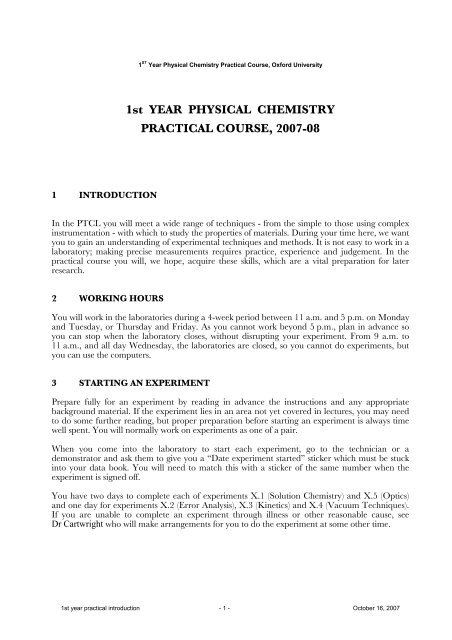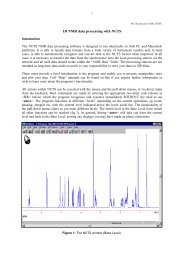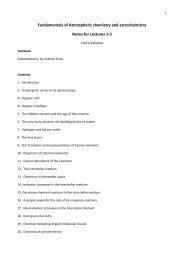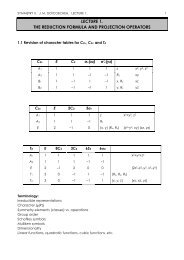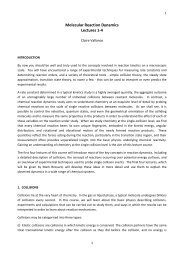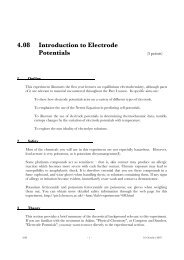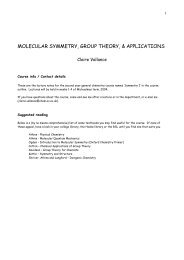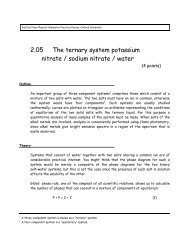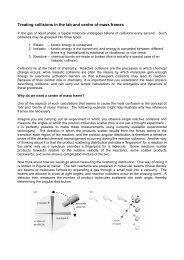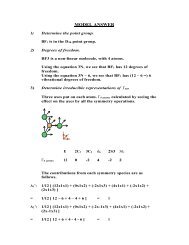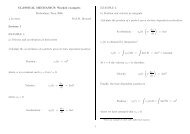1st YEAR PHYSICAL CHEMISTRY PRACTICAL COURSE, 2007-08
1st YEAR PHYSICAL CHEMISTRY PRACTICAL COURSE, 2007-08
1st YEAR PHYSICAL CHEMISTRY PRACTICAL COURSE, 2007-08
Create successful ePaper yourself
Turn your PDF publications into a flip-book with our unique Google optimized e-Paper software.
1 ST Year Physical Chemistry Practical Course, Oxford University<strong>1st</strong> <strong>YEAR</strong> <strong>PHYSICAL</strong> <strong>CHEMISTRY</strong><strong>PRACTICAL</strong> <strong>COURSE</strong>, <strong>2007</strong>-<strong>08</strong>1 INTRODUCTIONIn the PTCL you will meet a wide range of techniques - from the simple to those using complexinstrumentation - with which to study the properties of materials. During your time here, we wantyou to gain an understanding of experimental techniques and methods. It is not easy to work in alaboratory; making precise measurements requires practice, experience and judgement. In thepractical course you will, we hope, acquire these skills, which are a vital preparation for laterresearch.2 WORKING HOURSYou will work in the laboratories during a 4-week period between 11 a.m. and 5 p.m. on Mondayand Tuesday, or Thursday and Friday. As you cannot work beyond 5 p.m., plan in advance soyou can stop when the laboratory closes, without disrupting your experiment. From 9 a.m. to11 a.m., and all day Wednesday, the laboratories are closed, so you cannot do experiments, butyou can use the computers.3 STARTING AN EXPERIMENTPrepare fully for an experiment by reading in advance the instructions and any appropriatebackground material. If the experiment lies in an area not yet covered in lectures, you may needto do some further reading, but proper preparation before starting an experiment is always timewell spent. You will normally work on experiments as one of a pair.When you come into the laboratory to start each experiment, go to the technician or ademonstrator and ask them to give you a “Date experiment started” sticker which must be stuckinto your data book. You will need to match this with a sticker of the same number when theexperiment is signed off.You have two days to complete each of experiments X.1 (Solution Chemistry) and X.5 (Optics)and one day for experiments X.2 (Error Analysis), X.3 (Kinetics) and X.4 (Vacuum Techniques).If you are unable to complete an experiment through illness or other reasonable cause, seeDr Cartwright who will make arrangements for you to do the experiment at some other time.<strong>1st</strong> year practical introduction - 1 - October 16, <strong>2007</strong>
4 NOTEBOOKSKeep a record of experimental data in a hardback notebook. You must hand this in toDr Cartwright by the end of 4th week, Trinity term, in your 3rd year. Write your name on thespine of the book and maintain at the front an index of experiments completed.As you do an experiment, record measurements and results in the space provided on theworksheets, or in your data book if there is no appropriate place on the worksheet. When youmust take many measurements (for example, during a titration), it is usually helpful to plot thedata as the experiment proceeds, even if the instructions do not explicitly suggest this. It will thenbe easier to spot dubious data and errors made during the experiment.Ask a demonstrator to countersign your results during the time you are in the laboratory, toindicate that (s)he is satisfied with the way you are working. (This must be done while you areworking, not later. Demonstrators will not sign your data once the experiment is over, and it maynot be possible to get an experiment signed off if the data are not countersigned.) When theexperiment is complete, fill in a comments slip and post it in the box near the booking board, ifyou have any helpful comments to make.5 REPORT FORMATYour first year experiments are written up partly on the worksheets that comprise this manual,and partly in your data book. The instructions will make clear where you are to do the write-up.All work should be written neatly in correct English; demonstrators may not accept sloppy orgrammatically incorrect reports.6 SIGNING OFFEach first year experiment must be signed off as soon as you complete it; there should be no needto take the worksheet away for further embellishment before the demonstrator can sign it. Takeyour completed worksheet and data book to a demonstrator in the laboratory in which theexperiment is located and ask to be signed off.Once you have been signed off, make sure that a white signing-off slip is completed and signed,and add the appropriate stickers to the signing-off slip and the end of your report.7 APPARATUSMajor apparatus for experiments is set out on the benches. Glassware may be obtained from theglassware cabinets; for other requirements, see the technicians.Clean the apparatus and bench area when you finish an experiment. Rinse out glassware andleave on the draining board. If the apparatus is faulty in any way, report this to a technician, evenif you caused the problem. If not reported, a problem may remain undetected until the nextstudents attempt the experiment. Do not leave unlabelled liquids in beakers or flasks - these canpresent a hazard to the technicians.8 WEB SITEA web site is available for the practical course in physical chemistry at the following URL:http://ptcl.chem.ox.ac.uk/~hmc/tlab/tlabtl.html. This contains safety and other informationwhich you may find of value.<strong>1st</strong> year practical introduction - 2 - October 16, <strong>2007</strong>
9 EXAMINATION REQUIREMENTSEach experiment in the PTCL practical course is allocated a number of points, reflecting itsdifficulty, length and educational value. In the first year, you must complete all five experiments(which are worth a total of 21 points).By the end of 4th week in Trinity term of your 3rd year, you must have completed 3-year coursesof practical work in two of the three laboratories (Physical, Organic and Inorganic) and a 2-yearcourse in the third. If you pass a supplementary subject, you need do a 3-year course in only onearea and two 2-year courses. There is at present no 2nd-year requirement in physical chemistry,but you are advised to ensure that at least some experiments are completed during your 2 nd year.10 QUESTIONS?Help on any aspect of the practical course in the PTCL is always available fromDr. Hugh Cartwright, room 34-04, Hugh.Cartwright@chem.ox.ac.uk<strong>1st</strong> year practical introduction - 3 - October 16, <strong>2007</strong>
5. Laboratory coats and shoesYou are not required to wear a laboratory coat, but it is advisable to do so during any experimentin which toxic or corrosive chemicals are being used, to protect yourself and your clothes fromchemical spills. However, do be aware of the danger that laboratory coat sleeves may catch onequipment if you have to reach across the bench. Lab coats should not be nylon-based; this burns,melts and sticks to the skin, leading to very serious burns. Open-toed shoes or sandals should notbe worn except in the computing area.6. Tidy workingKeep your working area tidy. A cluttered bench is a common contributory factor to accidents, sodo not collect dirty glassware as the experiment proceeds. Instead, clean and reuse or leave at thesink any glassware that you no longer need.7. Disposal of chemical wasteWhen you have finished using a chemical, do not keep any excess at the bench, but immediatelydispose of it as appropriate; this may be down the sink, in a waste container, or back into theoriginal container. Ask the technician how to get rid of chemicals if you are in any doubt. Do notleave solutions for the technician to deal with, especially in unlabelled containers. Do not addnon-chlorinated solvents to the chlorinated waste containers, or vice versa. On no account washtoxic organic material or metal salts down the drains; if you do, you may be drinking it a few dayslater.8. Disposable glovesIf you are using toxic or corrosive chemicals you may wish to use protective gloves. When it isessential that such gloves be worn this will be indicated in the text; if on other occasions you wishto wear gloves, ask the technician for a pair, and replace them as needed. Note that somechemicals, such as platinum salts, can cause sensitization. Gloves should be worn when handlingthese compounds (but platinum metal itself is not a sensitizer).9. SpillsAlways clean up a chemical spill without delay. If you spill a toxic, flammable or corrosivechemical, call a demonstrator or technician immediately.10. PipettingDo not pipette by mouth, even solutions that you believe to be harmless. The solution may be lessinnocuous than you think, or there may be contamination on the pipette that you may get intoyour mouth.11. Flammable materialsWhen working with flammable liquids, start by checking that the area immediately around whereyou work is free of flames, and hotplates. A volatile organic chemical such as diethyl ether can beignited by contact with the surface of a hotplate - no naked flame is required.12. High-pressure gasesIf you have not used a high-pressure gas regulator before, ask for assistance the first time youneed to use it. Large gas cylinders contain a great deal of stored energy and have the potential tocause serious accidents.<strong>1st</strong> year practical introduction - 5 - October 16, <strong>2007</strong>
13. Tubing and glassWhen sliding rubber tubing onto glass (for example, using a pipette with a flexible filler) use theminimum possible force and a gentle twisting motion. If you use excessive force and the glassbreaks you will drive broken glass into your hand or wrist and cause serious (possibly lifethreatening)cuts. In case of difficulty, ask a demonstrator or technician for help; special glovescan be provided if necessary. To remove rubber tubing it is often safest to cut the rubber tube offrather than trying to pull it off.14. Fire alarmsIf the fire alarm sounds evacuate the laboratory without delay. If time permits, make yourexperiment safe if this will take no more than a few seconds, but do not take time out to retrievepersonal belongings (or take a trip to the toilet!) The assembly point for this building is outside themain entrance on the opposite side of the road, infront of the old Dyson Perrins building. Do notstand in the road itself, since access must be kept clear for emergency vehicles.15. Spills onto skin or eyes, ingestion or inhalation of chemicalsIf you spill a chemical on the skin, wash it off immediately with plenty of water. If a chemical getsinto your eye, inform your fellow worker or another person in the laboratory and immediatelyirrigate the eye with water from one of the taps - a flexible rubber hose is attached to many tapsfor this purpose. If you get a chemical in your mouth, wash the mouth out with waterimmediately. In every case the demonstrator and technician (who is a trained first aider) must beinformed immediately so that further action, if necessary, can be taken.16. Special rules for pregnant womenThe foetus, especially in the first trimester, is particularly vulnerable to damage from chemicals. Ifyou are pregnant, or believe that you might be, you are encouraged to talk to Dr Cartwright sothat he can assess whether any restrictions on the experiments you will do would be advisable.You may alternatively wish to consult your College chemistry tutor or the College nurse who willliaise with Dr Cartwright if necessary.17. Pre-existing conditionsIf you suffer from any condition which may lead to sudden illness, or if you must take, even for ashort time, drugs which may affect your performance in the laboratory, obtain a medical recordsheet from Dr. Cartwright. In case of emergency, it may help if this has been completed and stuckinside the back cover of your laboratory data book.18. AccidentsReport any accident immediately, no matter how minor, to the demonstrator on duty. There is aFirst Aid room in the PTCL library and First Aid kits in the technicians' preparation rooms ineach laboratory. The technicians are trained in emergency first aid.If you have any suggestions or concerns about safety in the laboratory, please see Dr Cartwright.<strong>1st</strong> year practical introduction - 6 - October 16, <strong>2007</strong>


